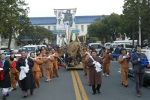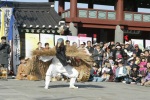 Spring has arrived! It may still seem like winter here in the northern hemisphere, but in early agrarian societies both in Asia and Europe, the spring season began in early February, the precise date determined by a lunisolar calendar and the sun’s position at what we today deem the 315° celestial longitude.
Spring has arrived! It may still seem like winter here in the northern hemisphere, but in early agrarian societies both in Asia and Europe, the spring season began in early February, the precise date determined by a lunisolar calendar and the sun’s position at what we today deem the 315° celestial longitude.
Spring has arrived. A traditional time of new beginnings, here on Jeju Island it is marked by indigenous animistic rituals and a large public festival. In this community of “18,000 gods” the proper deities are first invoked by shamans, after which all participants — shamans, musicians, celebrants, and spirits — form a procession through the streets from the preliminary site to the main stage, a grouping of official buildings from the Joseon era.
 The primary ritual on the second day focuses on the shamans’ supplication to the gods for a bountiful growing season and the health and fortune of the community. Activities also include a mask dance / drama which tells the tale of a farmer and his need of the gods’ beneficence, a calligraphic artist’s work on a giant paper canvas to produce an ode to spring (traditionally, each household would produce such a poem on this day and post it by their door or gate), the making of ‘gime’ or shamanic paper art for the altar — and everyone eats special Ipchun noodles.
The primary ritual on the second day focuses on the shamans’ supplication to the gods for a bountiful growing season and the health and fortune of the community. Activities also include a mask dance / drama which tells the tale of a farmer and his need of the gods’ beneficence, a calligraphic artist’s work on a giant paper canvas to produce an ode to spring (traditionally, each household would produce such a poem on this day and post it by their door or gate), the making of ‘gime’ or shamanic paper art for the altar — and everyone eats special Ipchun noodles.
Spring has arrived. Despite the snow, ice, and frigid temperatures that remain in much of the northern hemisphere, this is the beginning of germination. Buds are already on the trees, swelling and preparing to burst open; seeds are sprouting and plants are sending up new shoots from beneath rotting leaves; migratory birds are returning and their song fills the air as they prepare to nest.
In the southern hemisphere, of course, just the opposite is occurring: in the lingering heat of summer, there is the first hint of coolness in the air, as the energy of earth — and humans — begins to turn inward.
But here in the north: Spring has arrived.
 The metaphor is always one of hope and renewal. When it seems that winter is still in full force, when it seems that the cold and barren state of the earth might linger forever, signs of hope for new growth emerge. We can easily miss them if we are too focused on the discomfort and indeed danger of winter.
The metaphor is always one of hope and renewal. When it seems that winter is still in full force, when it seems that the cold and barren state of the earth might linger forever, signs of hope for new growth emerge. We can easily miss them if we are too focused on the discomfort and indeed danger of winter.
Look for those signs of spring. Look for them not only outside of but also within yourself. What are you germinating? What new project, creativity, innovation, idea?
As our own energy stirs, our metabolism quickens, and we begin to emerge from our incubation: what will we contribute to our lives, our communities, our world…as the light and energy returns?

Dr. Anne Hilty is a Cultural Health Psychologist with a focus on the interplay of Eastern and Western theories of mental health as well as the mind-body connection. Her grounding is in the fields of cultural, transpersonal, and health psychology; she is additionally influenced by classical Chinese medicine, somatic psychology, and Asian shamanic traditions. Originally from the city of New York, Dr. Hilty lives on bucolic Jeju Island in South Korea, having previously lived in Seoul and Hong Kong.









